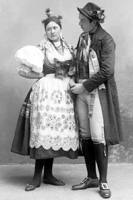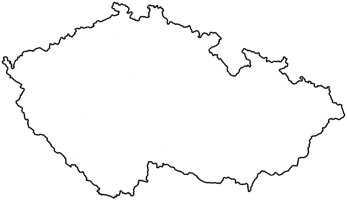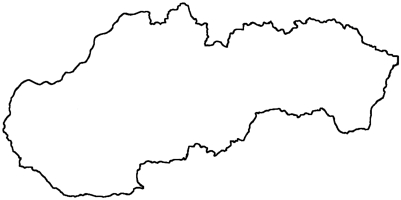
|
The Society of Folk Dance Historians (SFDH)
Choreogeography:
[
Home |
About |
Encyclopedia | CLICK AN IMAGE TO ENLARGE |

|

 It's very difficult not to use the "C" word (Czechoslovakia) anymore, but it is, in reality, no longer extant. The unfortunate split between these two groups of people is not unlike that in the less fortunate Yugoslavia, minus the bloodshed. It really shouldn't be so surprising, since the two countries (The Czech Republic and Slovakia) were formed at the same time by the same man (U. S. President, Woodrow Wilson) for the same reason – to dismantle the Austro-Hungarian Empire following World War I.
It's very difficult not to use the "C" word (Czechoslovakia) anymore, but it is, in reality, no longer extant. The unfortunate split between these two groups of people is not unlike that in the less fortunate Yugoslavia, minus the bloodshed. It really shouldn't be so surprising, since the two countries (The Czech Republic and Slovakia) were formed at the same time by the same man (U. S. President, Woodrow Wilson) for the same reason – to dismantle the Austro-Hungarian Empire following World War I.
Both countries were formed on the basis of a common language, Slavic, which existed within the German and Hungarian-dominated empire. No attention was given to the histories of the Slavic-speaking peoples on the fringes of the empire – peoples that had been at each other's throats for generations and who fervently relished old hatreds, dreaming of revenge in the most Medieval manner. We are now reaping the rewards of such ignorance.
The Croatian claim that Serbia has ursurped economic and political power is arguably true. The same situation existed in Czechoslovakia, where the Czechs, having the capital city of Prague securely within its borders, assumed control of much of the country's wealth. The Slovaks, far to the east in a rural wonderland, had little access to that power and reasonably felt left out, just as the Croatians did. It took little encouragement by nationalist leaders to persuade the Slovaks to pull out and go their own way, even if under a new version of the old socialist economic system.
The lack of warfare in the so-called "Velvet Revolution" can be attributed to the cultural personalities of the Czech and Slovak peoples. Fighting is just not in their nature. One native Czech, when asked if a war was pending, replied, "If they did start a war, it would only last until they got to the first pub. The Czechs would start drinking beer and the Slovaks would start on Slivovitz, and they would all go to sleep and forget the war." An interesting commentary on an entire cultural group, verified many times in discussions with citizens of both countries. A fine example for the rest of us!
So, now we have two countries where once there was one. As in most of Europe, each is a complexity of local ethnic groups, divided primarily by topography (mountains, open farm land, etc.). The characteristics of each group's folk life are mandated by their livelihood and their reactions to environmental forces.
THE CZECH REPUBLIC
 The Czech Republic (known as Česko by its inhabitants and by the short-form name Czechia in English) can best be divided into three "states:" Bohemia in the center, Silesia to the north along the Polish and German borders, and Moravia to the east, bordering Slovakia.
The Czech Republic (known as Česko by its inhabitants and by the short-form name Czechia in English) can best be divided into three "states:" Bohemia in the center, Silesia to the north along the Polish and German borders, and Moravia to the east, bordering Slovakia.
Bohemia is the largest and wealthiest region, strongly influenced by Austrian and German cultures. This large, circular, well-watered and -drained basin forms a rolling countryside with rich croplands and picturesque Medieval villages seemingly frozen in time. The Polka is the predominant dance there, with countless variations giving the dance a richness unmatched anywhere else. Intresting versions of the Bavarian dance Zwiefacher abound, with variations of 2/4, 3/4, and 4/4 rhythms. Lifts are also commonly found in Bohemian dance.
Bohemian costume is very Germanic, with the men wearing knee-length knickers and a waist-length vest, and the women's dress closely resembling the familiar German / Austrian "dirndl."
Silesia is less known as a folk art center, being heavily industrialized due to rich coal deposits. Heavy industry carelessly operated by past governments has seriously polluted the water and air of the countryside.
Moravia forms the eastern third of the Czech Republic, extending from the Polish border on the north to the Austrian border on the south.
North Moravia, called Wallachia, is a rugged, mountainous region, not unlike the American Appalachians. The people there are indeed Wallachians, having migrated from Romania hundreds of years ago. True to the traditions of mountain people throughout Europe, the dances there are athletic and vigorous, with high leaps and spins, whirling couples, and playful dance games.
Both men and women wear light, moccasin-like footwear. The women's costume is simple, yet charming, most often having skirts or aprons of their famous indigo wood block print fabric. Men's costumes generally consist of tight fitting blue trousers, a red vest, and a wide-sleeved white shirt. A strange, high-crowned hat with a wide curled-up brim is worn in many areas.
South Moravia physically resembles Bohemia, with open, rolling countryside and heavily cultivated areas. Comparatively wealthy, the area is clearly defined by natural borders and is one of the richest folkore centers in Europe.
There, surrounded by the powerful cultural influences of Austria, Hungary, Slovakia, and the Czech Republic, East meets West in a culture that seems to have taken the best from each to create its own unbelievably rich folk culture. It has been said by the Czechs themselves that the South Moravians are the "best Czechs."
The Czech Republic's rich natural resources and proximity to the precision-minded, industrious Germans, have created a unique cuture of gentle, music-loving, yet progressive people with a talent for technological innovation and a distinct capitalist outlook. A highly developed industrial base and a skilled work force seem to assure the republic's economic growth.
SLOVAKIA
 Extending eastward between the south slopes of the Carpathian Mountains and the northern border of Hungary, Slovakia reminds one of Switzerland, with the beautiful Tatra Mountains and lush rolling countryside. Its rural, conservative character has perserved much of their rich folk culture, celebrated in lively folk festivals all year round.
Extending eastward between the south slopes of the Carpathian Mountains and the northern border of Hungary, Slovakia reminds one of Switzerland, with the beautiful Tatra Mountains and lush rolling countryside. Its rural, conservative character has perserved much of their rich folk culture, celebrated in lively folk festivals all year round.
Though divided into many small regions, the country is most readily separated into four major areas: West, Central, North, and East, each with its own unique character. Parallel east-west mountain ranges tend to divide the Central region into subregions, each again with its own characteristics. Along its entire southern third, the population is heavily populated by Hungarian speaking people.
West Slovakia borders on the Czech Republic. It is a continuation of South Moravia, with many of the same characteristics in folklore, folk arts, music, costume, and dance. The famous couple dance, "Sellacky," with its lifting competitions between couples, comes from this area.
North Slovakia is the area around the High Tatra Mountains that separate Poland from Slovakia. Not surpirsingly, the same culture is found on both sides of the mountain range, with, of course, some local variations. Sheep and lumber are the traditional sources of livelihood, though for generations the Tatras have been a popular vacation area for Eastern Europeans. It is a wonderland of alpine mountains, hikers, naturalists, and just about anyone who appreciates natural beauty. Poprad, on the eastern end of the Tatras, is the major city of the region. The remote town of Ždiar is a popular ski resort and on the nearby Dunajec River, at the Slovak-Polish border, local guides take vacationers on thrilling raft rides, just as their predecessors did in centuries past.
Central Slovakia has long, narrow valleys that have fostered the creation of very local folk cultures, not unlike the karst regions of Bosnia-Herzegovina. Most well-known is the region around Detva. The folk costume there resembles that of Old Hungary, with the men wearing the wide linen trousers ("gatya") of the Hungarians, though decorated with Slovak embroideries. The "fujara," a unique, primitive oboe-like musical instrument with an unforgettable, haunting musical quality, is found there.
East Slovakia, surrounding the city of Košice, most closely resembles the land and culture of Hungary. The rolling countryside continues from Hungary's northern Mountains and extends to the border with Ruthenia, the so-called Carpatho-Ukraine.
Slovakia has chosen to separate from the former country of Czechoslovakia, preferring to go its own way. The conservative nature of its people resist the threatening, unfamiliar new capitalistic economy, retaining the socialist style economic system. After all, even that's an improvement over the old feudal land system they'd known in years past.
The country is poorer and less well developed than the Czech Republic and suffers economically for its decision to separate from them. It remains to be seen if they will take advantage of the country's potential in tourism and paper industries. Though the land is agriculturally rich, it has a poor transportation system, and has yet to develop a market for its products since the fall of the Union of Soviet Socialist Republics (USSR). For now, it is a romantic, economical, and somewhat sad place to visit, and a treasure trove for folk dancers.
DOCUMENTS
- Czechia, a country.
- Richard Duree, an article.
- Slovakia, a country.
Used with permission of the author.
This page © 2018 by Ron Houston.
Please do not copy any part of this page without including this copyright notice.
Please do not copy small portions out of context.
Please do not copy large portions without permission from Ron Houston.